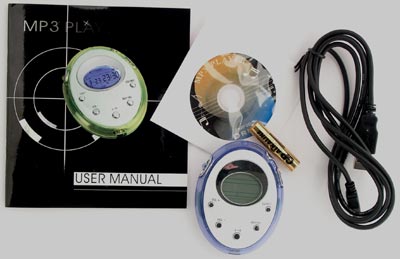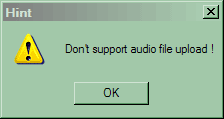 |
||
|
||
| ||
The market of players based on flash memory acquires more and more names. There are already several dozens of manufacturers, and the list keeps on growing up. Sometimes new companies are mostly known for other players (like Aiwa or iRiver), sometimes they are dedicated firms (like Eisen or MPMan, the founder of the market), and there are also companies who produce mainly something different, hardly related with multimedia equipment. Such situations are very beneficial for end-users because the greater the competition, the wider the range of models and the lower the prices. That is why it mustn't be a problem for you to find a player you dreamed of.  General look
The player is of the oval shape which is not widely used by developers. Its maximum dimensions are 79 x 62 x 15 mm, though it looks more compact at the expense of its shape. It weighs just 37 g (like a compact model), an AAA battery doesn't add much to the weight. The designers offer only one variation of the player coupled with 64 MB memory and of only one color. The display is pretty nice, but it doesn't display even tags. At the same time, the device features a powerful player, a dictaphone, handy management; also it emulates a disc drive when connected to a PC and supports update of the control microprogram. So, on the one hand, it sports an unsophisticated and elegant design excellently suiting ladies, but on the other hand, the filling is not the most functional one. Accessory packThe box the player ships in looks conventional, but it's closed with magnets. I see such approach for the first time.  Beside the player, we've found inside a USB cable, a 80mm CD with drivers and other software, a brief manual, an alkaline AAA battery and headphones.
 The headphones are of moderate quality. They can suit many users though most would probably prefer something more expensive. The headphones are combined with the neck strap, like it was done in the digit@lway MPIO DMK and what the iRiver iFP lacks. That is why it's very convenient to wear the player on the neck. I'm also glad they haven't forgot that people tend to have different ears, so they provided foam-rubber pads. Connection and softwareThere are no any pitfalls: just install the drivers and program-manager and then connect the player. However, the device manager shows that this is not a USB device but SCSI.  Unfortunately, such approach has some drawbacks. In particular, you should use Safe Device Removal before disconnecting it physically, otherwise next time the player won't be recognized and you will have to reboot the computer. The device manager shows two disc drives as the player emulates a standard such drive: one is for addressing the internal memory and the other is for an expansion card. Such approach is more convenient than that of the Daisy DIVA where the internal flash is locked when a card is used. Emulation of the disc drive allowed us to test a rate of data exchange
with a computer. Here are the scores (the internal memory on the left and
the expansion card on the right). They are far not impressive: the write
speed is lower than 2 Mbit/s while 2.5 Mbit/s is considered the minimal
acceptable value today (even crawling NetMD players have it higher, not
to mention flash models). The read speed is not that bad. In case of the
card, the write speed falls down to 1Mbit/s. However, the player itself
is not guilty - the MultiMediaCard standard is just unable of high speeds.
In principle, you can use any program such as FAR or Windows Explorer to record files into the player. But the CD offers a special manager:
 It doesn't differ much from programs of this class, it has neither outstanding features nor severe drawbacks, everything is standard: recording of any files into the memory or card, formatting of memory or a card, file ordering, recording of non-audio files back into a computer. Well, it protects from recording music into a computer:
 However, you can easily use the FAR in this case. But the original firmware versions had some errors which caused failure of operation of the player when I used a file manager. I had to do my best to bring it back to life, after that I changed the firmware version and then completely forgot about the Audio Manager. MemoryAt present, the player comes complete only with 64 MB memory. But I'm sure that if they put it into the mass production, there will be other versions, at least, one with 128 MB flash memory. And now its scantiness can be avoided only with expansion cards of the MMC type. Unfortunately, this standard is fading away because of its low data rate, and the player is not compatible with modern SD cards. But it should be noted that the MP200 works excellently with 128 MB cards, unlike many other devices designed for MMC. So, the maximum memory size the player can have now is 192 MB flash, and you can take a couple of MMC cards with you. Just remember that the cards should be formatted for the FAT16, otherwise the player won't see them. File types supportedIt provides support for MP3 and WMA with various compression parameters. In case of MP3 all sampling frequencies and bitrates are available, though you can have problems, namely artifacts, at 48 kHz in the WMA format. But it can be tackled in newer firmware versions. That is why this is one more player (beside the Zillion) able to work at such frequency in these files, - this is not under the power of more expensive models. There is also a problem with WMA files of VBR: the MP200 plays them with no response with any keys, and on completion of the playback it remains at the end of the file (it can be solved only by reinserting the batteries). In case of the constant bitrate it's OK with files of all format versions (V2, V7, V8 or V9) - it plays even at 320 Kbit/s which is not typical of the iRiver iFP. The decoder yields a bit to the Zillion's one (doesn't support AAC files) and outshines 99% of players, but it's still too raw. If they do not make the corrections, they player will look much less attractive than it could be. DictaphoneThe dictaphone is not complicated, though it works well. File parameters are IMA ADPCM, 32 Kbit/s, mono, 8 kHz. Compression is a little bit weak, and the bundled 64 MB can house only 4 hours of speech, but it's quite enough for nonprofessional use. ManagementEverything is simple and handy - there is one slider (to lock the buttons), Jog-Dial (Play/Pause, FF, REW - like in other models) and five buttons on the front panel. Two are for volume control, another for the A-B mode and the rest depend on the current mode. In the playback mode the REP/DEL button switches between the repeat modes (Random, Normal, Repeat All, Repeat One, Preview; the latter is a synonym of Intro), and in other cases this button lets you delete files. EQ/REC switches between the equalizer presets (Jazz, Classic, Rock, Pop, Normal) or records a file with the built-in microphone. Unfortunately, the player is sclerotic: it doesn't remember a played position at all. I hope it will be eliminated soon. DisplayThe worst downside of the player is that it doesn't display tags, though this LED is a very good ergonomic solution. The symbols are big and clear, the blue backlight is attractive... The display shows a volume level, repeat, A-B and equalizer modes, battery status, a number of a current file and the overall number of files in the memory, a played position and some other useless information like whether the card is inserted and whether the player is connected to a PC. Power supplyLike many other compact models, the MP200 uses AAA batteries. According to the manual, one battery lasts 12 hours, though the real time is less - the rechargeable battery of 700 mAh works about 7 hours. Unfortunately, the player can't get power via USB, that is why it runs of the change even when connected to a PC (which is twice as bad taking into account a low data rate). SummaryMany ideas of the developers are very interesting: the body design, decoder,
and PC connection. The fact that tags can't be displayed is not a weak
point for many out there. But the player needs much working on as it's
still raw. Only in this case this model, though not outstanding, may succeed
on the market.
Andrei Kozhemyako aka Korzh (korzh@ixbt.com)
Write a comment below. No registration needed!
|
Platform · Video · Multimedia · Mobile · Other || About us & Privacy policy · Twitter · Facebook Copyright © Byrds Research & Publishing, Ltd., 1997–2011. All rights reserved. |